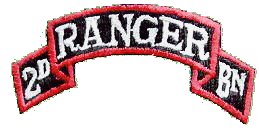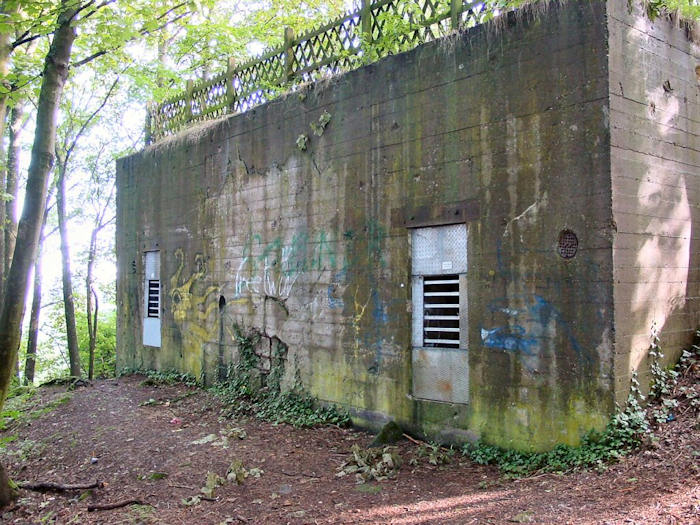6-8 DECEMBER, 1944 - (RHINELAND CAMPAIGN)

By Lt. Frank U. Roquemore
OPERATION HILL 400
6 - 7 DECEMBER
Moving on foot from HURTGEN, the Rangers followed the road to BRANDENBERG and thence to BERGSTEIN, arriving on the northwest edge of town at 0200 where the battalion commander halted the column. (See Map D) At this point, the company commanders went forward to receive further orders and make a reconnaissance of the area.
Guides from the armored elements in BERGSTEIN failed to meet the company commanders at prearranged points so the reconnaissance was completed without assistance hut consumed valuable time. Coordination was established with the armored commander during this time by the Ranger commander after locating the command post. (36)
During the march and while halted, enemy artillery was placing harassing fire on the BRANDENBERG-BERGSTEIN road, and mortar fire on the town of BERGSTEIN. Friendly artillery and tanks from positions to the rear were placing occasional fire on Hill 400. Some buildings in BERGSTEIN were burning due to these and previous fires, and aided the Rangers in orienting themselves. (37) The battalion suffered no casualties from the enemy fire but the rain and seeking cover in roadside ditches had drenched men and equipment. When the column halted, some of the men found cover from the rain and enemy fires by placing themselves under tanks and half tracks which had been disabled by an enemy mine field across the road and along the edge of town. (38) At the time the Rangers arrived on the edge of town, the mine field was being removed by engineers of the 1171st Engineer Combat Group to clear routes of communication. (39)
The company commanders returned to their companies and at 0300 Companies A, B and C moved in column from the northwest edge of town to their assigned objective, the high ground southeast of town. No enemy was encountered during the move to these positions other than the enemy harassing artillery and mortar fires.
Company A occupied positions previously prepared by the enemy before withdrawing. Companies B and C proceeded to prepare their defensive positions. All three companies had completed their occupation and preparation of defensive positions prior to daylight. (40,41)
Following the movement of Companies A, B, and C, Companies D, E, and F moved from the northwest edge of town to their tentative line of departure on the eastern edge of town. During this move, these companies found it necessary to clear some houses of enemy which had infiltrated into town during previous enemy counterattacks and darkness. This enemy consisted of small harassing elements,offering little resistance and were quickly eliminated. Several enemy were taken prisoner with no casualties suffered by the Rangers. (42)
In the early morning hours, Companies A, B, and C southeast of town observed enemy vehicles, probably self-propelled guns, several hundred yards to their front, or south of BERGSTEIN. An artillery concentration was requested by A Company through the battalion command post and adjustment of fire made by the men on the front line. One tank of the 5th Armored elements in town also fired on these vehicles. Neither the results of this fire, nor the exact type of vehicle could be determined due to the ground haze. The enemy vehicles did take cover after the fire. (42)
Companies D, E, and F, from their positions on the eastern edge of town, crossed their line of departure in a general skirmish line at approximately 0700. (41)
These companies moved rapidly across the open ground. between Hill 400 and BERGSTEIN and assaulted the hill. Enemy ground resistance was relatively light but accurate small arms fire and enemy shells falling in the area caused some casualties. The majority of the hill defenders, evidently a delaying force, withdrew to wooded areas east of the hill position. (43)

The open ground in front of Hill 400
Enemy troops defending this terrain were later identified through prisoner interrogation. From the Intelligence Operations, V Corps in Europe, page 68, "The enemy defenses of the hill had been entrusted to a special task force created from the companies of 1055 Infantry Regiment (89th Infantry Division)".
At 0830, Companies D, E, and F reported by radio to the battalion command post that their mission was complete and the hill secure. (43,44)
While the attack on the hill was in progress, and once the enemy determined an attack was in progress, heavy artillery and mortar fires were placed on BERGSTEIN and the BRANDENBERG-BERGSTEIN road. After the Bangers seizure of the_hill, the enemy shifted the weight of his fires onto the hill and used only intermittent mortar fires against the town itself. These fires came from enemy positions south and east of BERGSTEIN as well as from positions east of the Roer River. (45)
As a result of the enemy fires on the hill, the companies began to suffer heavy casualties, having had no time to dig emplacements. Evacuation of wounded immediately became a serious problem.
To cope with the casualty problem, the battalion medical officer moved the aid station into a church in the northeast part of town and established a collecting station in a pillbox on the hill.

Pillbox #341 on top of the hill.
Nowadays a bat habitat.
Both these installations were under the same fire that fell on the hill and town but of necessity had to be close to the troops. Despite the valiant efforts of the medical officer and his aid men, some casualties had to await darkness before receiving aid. The medical officer was killed by enemy mortar fire on the next day while performing his duties. (46)
Meanwhile, the companies southeast of town were receiving some casualties from enemy artillery and mortar fire but were not being depleted as was the force on the hill. (47)
Enemy fire continued falling in the area for the remainder of the day, varying in intensity. The Rangers southeast of town removed machine guns from disabled tanks and half-tracks to incoporate into their main line of resistance. Preparations were made for the expected enemy counterattack. Communication between the battalion command post and the companies was a problem. Radio had to be used almost entirely. Wire lines had been laid to the companies but these were continuously being severed by enemy fire (47)
Between 1055 and darkness the enemy launched two counterattacks against the companies on the hill. (48) Both of these attacks were preceded by artillery and mortar preparations on Hill 400 and BERGSTEIN.
The attacking forces consisted of approximately 150 enemy infantry in both attacks. During the first attack, the enemy approached to within small arms range by following the artillery preparations; this attack was repulsed primarily with accurate small arms fire.
After being repulsed on the initial attack, the enemy withdrew and reorganized. The second attack saw the enemy employing fire and maneuver in an attempt to close with the Rangers. This attack was likewise repulsed by accurate small arms fire but only after the enemy succeeded in coming within close range.
The enemy attacks failed to make a penetration of the Ranger's positions but did succeed in causing more casualties by mortar and sniper fire. (49)
Late in the afternoon, the battalion commander ordered A Company from its positions southeast of town into BERGSTEIN. A Company was to act as a reserve and counterattack force should the need arise. (50)
This company was further assigned the mission of eliminating any enemy that succeeded in surrounding the companies on the hill, or infiltrated into the town to harass friendly troops. Some enemy snipers were believed to be in parts of the town but there was no confirmation on this. (50)

